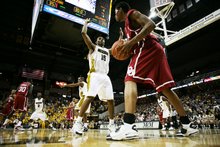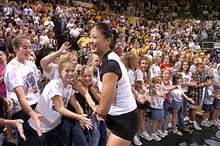I figured it would be fun (and a bit painful) to scroll through the two most memorable MU-NU affairs in recent memory in the run-up to next Saturday. First up (of course): 1997. I’ll post a couple articles a day.
NOVEMBER 8, 1997
In September, Corby Jones was advised in the Missouri student paper that he should consider switching positions -- to water boy.
In September, Scott Frost was booed by his fellow Nebraska students when he struggled in a home game against Central Florida.
It's November now, and in the opinion of many observers, the best two quarterbacks in the Big 12 Conference will be wearing No. 7 on Faurot Field today when Jones' Tigers (6-3 overall, 4-2 Big 12) play host to Frost's Cornhuskers (8-0, 5-0) in a 2:30 p.m. game.
“I think you're going to see the two top candidates on the field,” said MU coach Larry Smith when asked who he considered the Big 12's best quarterback. “I think we do” have the best one, “but I think you're going to see the other one.”
You could argue all day about which one is better. You could argue all day about what the criteria for the argument should be.
Statistics?
Jones leads the Big 12 in total yards with an average of 229 yards per game. Frost is seventh with an average of 171 yards. But Jones has more carries and passing attempts than Frost, who rarely plays all four quarters because the Cornhuskers usually rout their opponents.
Jones has been the more effective passer with an efficiency rating of 133.9 compared to 118.3 for Frost. But Frost has averaged 6.1 yards per carry to Jones' 4.8.
Leadership?
Frost has guided his team to a flawless record. After hearing the boos the previous week, he responded with a terrific game at Washington on Sept. 20. He scored on runs of 34 and 30 yards as Nebraska, which was an underdog for the first time in four years, beat the Huskies 27-14. That was NU's closest game of the year.
Jones has led his team to its first winning season since 1983. He began the season with subpar outings against Eastern Michigan and Kansas, but has turned it around, especially in the passing game. With the Tigers trailing 37-30 with less than two minutes to play at Oklahoma State, Jones led an 80-yard touchdown drive to tie the game, which MU won in overtime.
So who is better?
“You really think I'm going to answer that question?” Jones said with a smile. “I hope you really don't believe that.”
Father's sons
This question of which quarterback is better could have been answered by no less an authority than Tom Osborne if Jones had accepted Nebraska's scholarship offer after his senior season at Hickman High School in 1994.
Jones had narrowed his choices to Missouri, Illinois and Nebraska when NU quarterbacks coach Turner Gill, who had coached with MU assistant Curtis Jones at Southern Methodist, told Corby where he was headed.
“Turner basically told me that I wasn't interested,” Jones said last year. “He said, `Look, if you want to come, we've got a scholarship for you. Coach Osborne wants you, and we want you here, but I don't see you leaving your dad.' “
Gill was right, Jones belonged with his father at Missouri.
In his third year, Jones has rejuvenated an underachieving program with his superb play and is an ideal front man for the team. He is charismatic and articulate, cooperates with the media win or lose and moves comfortably in the spotlight that accompanies the big man on campus.
Frost also followed in his father's footsteps, although he took a round-about route.
Larry Frost played halfback for the Cornhuskers from 1967-69, and his wife, Carol, is a former NU track athlete who won a gold medal in the discus at the 1968 Olympics in Mexico City. But when Scott graduated from Wood River, Neb., High School, he chose to go his own way and attend Stanford and play for Bill Walsh.
“I wanted to try something different,” Frost said. “I wanted to get a chance to play in that offense. Stanford offered a great education. I got caught up in the fact it was out on the West Coast and was kind of new and exciting. It was something I just wanted to try.”
Frost spent his time as a backup quarterback and safety, and the Cardinal struggled. Walsh left, and Frost decided to do the same, transferring to Nebraska.
After sitting out a year, Frost took over last year for a team that was coming off consecutive national championships. He didn't do badly, completing 104 of 200 passes for 1,440 yards with 13 touchdowns and three interceptions. He also rushed for 438 yards.
But the Huskers lost two games, including a 37-27 defeat to Texas in the Big 12 championship game that cost NU a shot at its third straight national title. That's not good enough by Nebraska standards.
Breakthrough seasons
Frost wasn't the only guy with something to prove this year.
Jones grew weary of his reputation as a running quarterback last year. In obvious passing situations, Smith turned to Kent Skornia to lead the Tigers until Jones finally wrestled away the full-time job in November. He led MU to back-to-back victories over Baylor and Kansas to end the year and then went to work in the off-season.
He worked almost daily on his passing skills with his receivers. The results have been dramatic. Jones has completed 85 of 164 passes for 1,360 yards and nine touchdowns.
“I think last year everybody knew Corby could make the plays in the run game and they weren't real confident in him making a lot of plays --they saw him make a few but not a lot of plays -- that scored points consistently,” Smith said. “I think that's what he's brought to the table this season.
“He is a threat deep for touchdowns, short, intermediate, third-down situations, first-down situations. That's helped him become a more of a complete quarterback.”
With a far superior supporting cast, Frost's progress is a little harder to gauge. With running backs Ahman Green and Joel Makovicka chewing up yards, Frost hasn't had to carry the burden of an offense the way Jones has. But he simply hasn't made any mistakes.
“He directs our offense really well,” Osborne said. “He's a knowledgeable guy who really handles the option game well and he's a very effective thrower when you call on him. So his stats may not benefit him, but in terms of value and contribution and moving the football, he's done a great job and is probably one of the top quarterbacks in the country in terms of effectiveness.”
Today Jones will be asked to do the unreasonable, beat No. 1 Nebraska almost single-handedly. He is one of the few Tigers with the athletic ability to make big plays against the Cornhuskers. MU needs a whole lot of big plays.
Frost doesn't face that kind of burden. The Cornhuskers would be heavily favored with Grant Wistrom at quarterback. But Frost knows his judgment will be delayed. His legacy will be shaped by whether he can lead Nebraska to the national title.
“The end of this season will have a lot to do with how people remember me and this senior class,” Frost said. “If we can somehow go back and win another one, people will remember nothing but good things. If we don't, it's hard to tell. It's unfortunate that everything you do comes down to a game or two, but I guess that's life.”
By JOE WALLJASPER
---
NOVEMBER 8, 1997
Football used to set this town on fire.
In the 1970s, battalions of state troopers on game days used to funnel one-way streams of traffic toward Faurot Field; students used to camp for days in tent villages in front of the ticket booth to procure the best seats for the season; and downtown streets were blocked off to accommodate the throng of fans who hopped from bar to bar.
Last night at Harpo's, the undisputed “Keeper of the Flame” of Tiger football, fans gathered on the eve of Missouri's game against No. 1-ranked Nebraska to savor the possibilities of this season and to relive the past.
“Every game was an all-day party,” MU alumnus Mark Bumgarner said of the winning seasons so long ago. “You got a date and never questioned where we were going to go.”
His friend Jerry Carlson agreed. “It was more than a football game -- it was an event.”
Today, the ashes of 15 years of losing seasons cover the blazing glory of MU football teams past. Many alumni hope the 65,000 bellowing fans expected at Memorial Stadium this afternoon will breath new life into the flickering flame.
They are also hoping for a repeat performance of the 1978 game, when MU stunned the Cornhuskers, then No. 2, by defeating them 35-31 on their home field. James Wilder strong-armed a Nebraska tackler on the 3-yard line to score the winning touchdown.
“I remember watching him throw that guy off and dive into the end zone to win that game,” said alumnus Jim Stark. “He was a man among boys.”
A large contingent of Nebraska fans also gathered at Harpo's last night, a welcome sight to owner Randy Harper. “Nebraska fans are the best in the Big 12 Conference,” Harper said. “All the businesses look forward to them coming to Columbia every other year.”
Harper estimates a crowd as large as today's can give a $6 million boost to Columbia businesses, from florists to filling stations.
Larry Fuller, an MU alumnus who lived in Lincoln, Neb., during the 1970s, said Nebraska fans are not only the best in the Big 12, “they're the best in the whole world.”
At a party at Fuller's home last night for a large contingent of MU and Nebraska fans, MU alumnus Chuck Hatley said he's looking forward to seeing every seat full for the first time in a decade. “Even if we lose, to be there with 65,000 fans is exciting -- it makes you hungry to go back.”
Hatley said recent graduates have no memory of those football traditions, which burned out while some of them were still in grade school.
“Alums all the way into their early 30s have never seen a winning season,” he said.
Realistically, most fans don't think MU can beat Nebraska today, but as one person said, “Stranger things have happened.”
In the 1970s, the Tigers were giant killers -- a team that could topple any opponent regardless of rank or record.
Many thought back to 1976, when MU fans, buoyed by MU's 22-21 victory at No. 2 Ohio State, stormed Faurot Field in the dark and leveled the goal posts. As tradition warrants, they delivered the severed limbs to the sacrificial altar of Harpo's.
One anonymous alum said, “If we win tomorrow, the goal posts are least of our problems -- the Columns could come down.”
By JANICE WINTERS
---
NOVEMBER 8, 1997
Colorado coach Rick Neuheisel couldn't believe his eyes. The uniforms belonged to Missouri, but the offense was Nebraska, or at least Cornhusker Light.
The Tigers were cranking out 15-play, 80-yard, 71/2-minute drives, and Colorado was helpless to stop them in a 41-31 MU victory. An athletic quarterback ran the option and threw the occasional play-action pass, bullish fullbacks landed body blows to the belly of the defense and hard-running tailbacks chipped away 6 yards at a time.
Neuheisel wasn't the only one to notice Missouri has patterned its offense after the Big Red Machine. While NU quarterback Scott Frost sat in a Waco, Texas, hotel room waiting for his team's night game against Baylor, he caught some of the Missouri-Oklahoma State game on television and saw plenty of familiar sights.
“I recognized a lot of plays that we run that they run too,” Frost said. “Maybe some of the blocking schemes are different, and I'm sure we have plays they don't run and they have plays we don't run, but as far as the basic theory of an offense and style of play, I think they're pretty close to the same thing.”
The catch is that Nebraska's offense never has to play against Nebraska's defense in a game. Missouri's offense does today in a 2:30 p.m. game at Faurot Field.
MU's current scoring average of 32 points is the highest since the 1969 Orange Bowl team averaged 33.2. In the last three games, the Tigers have averaged 43 points. But Missouri (6-3 overall, 4-2 Big 12) hasn't faced a defense like Nebraska (8-0, 5-0).
“Their defense, you look at tape, and you grind and grind and grind on the tape and try to find something you can make go consistently,” Missouri coach Larry Smith said. “The biggest thing is they've been using the same scheme now for four years.
“They've put in a few little wrinkles, but for the most part it comes down to on defense they've got great athletes, great quickness and speed at every position.”
The Cornhuskers are ranked No. 3 in the nation in total defense and No. 4 in rushing defense. They have given up only seven points in the last three games.
“The things we can't do, No. 1, is turn the ball over, and No. 2, we can't have negative plays,” MU offensive coordinator Jerry Berndt said. “They're whole team thrives on turnovers and negative plays.”
Berndt said that Nebraska's scheme forces opposing offensive lines into a series of one-on-one blocks. Any weak link on the O-line gets exploited all day because it's hard to give him any help.
If Missouri's inside running game is going to work, Tiger guards Mike Morris and Craig Heimburger and center Rob Riti will have to win head-to-head matchups with All-American defensive tackle Jason Peter and the 310-pound Jason Wiltz.
Missouri had absolutely no luck getting around the corner with the option game against Nebraska last year, and Corby Jones was knocked out of the game after taking several vicious shots. The Cornhuskers haven't gotten any slower since then, and senior defensive end Grant Wistrom is the playing the best football of his career.
The All-American from Webb City forced three fumbles, recovered one and made two sacks in a 69-7 victory over Oklahoma last week. He might be the most disruptive defensive player in the nation.
To move the ball on such a defense, Missouri will probably have to place its faith in the passing and scrambling of Jones. The junior quarterback has averaged 205 yards passing and 63 yards rushing in the last three games.
Texas was able to beat the Huskers 37-27 last year by letting the mobile James Brown buy himself time to pick apart the Nebraska secondary.
“Texas made some big plays last year, and that's one thing we have to do,” Berndt said. “If you're going to beat them, you have to make some big plays. You're not going to have 17-play drives against this football team. They don't allow you to do that. That doesn't mean we can't, but you don't have many of those.”
By JOE WALLJASPER
Wednesday, September 26, 2007
Mizzou-Nebraska Redux: 1997
Posted by
The Boy
at
2:10 PM
![]()
Labels: Mizzou football, Mizzou-Nebraska
Subscribe to:
Comment Feed (RSS)






|